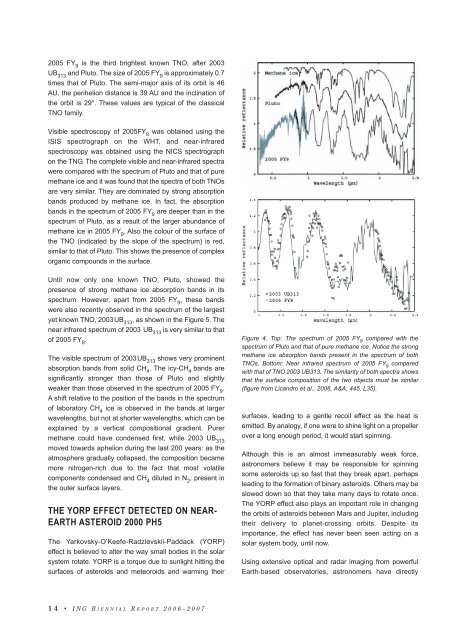PDF (6M) - Isaac Newton Group of Telescopes - Instituto de ...
PDF (6M) - Isaac Newton Group of Telescopes - Instituto de ...
PDF (6M) - Isaac Newton Group of Telescopes - Instituto de ...
Create successful ePaper yourself
Turn your PDF publications into a flip-book with our unique Google optimized e-Paper software.
2005 FY 9<br />
is the third brightest known TNO, after 2003<br />
UB 313<br />
and Pluto. The size <strong>of</strong> 2005 FY 9<br />
is approximately 0.7<br />
times that <strong>of</strong> Pluto. The semi-major axis <strong>of</strong> its orbit is 46<br />
AU, the perihelion distance is 39 AU and the inclination <strong>of</strong><br />
the orbit is 29°. These values are typical <strong>of</strong> the classical<br />
TNO family.<br />
Visible spectroscopy <strong>of</strong> 2005FY 9<br />
was obtained using the<br />
ISIS spectrograph on the WHT, and near-infrared<br />
spectroscopy was obtained using the NICS spectrograph<br />
on the TNG. The complete visible and near-infrared spectra<br />
were compared with the spectrum <strong>of</strong> Pluto and that <strong>of</strong> pure<br />
methane ice and it was found that the spectra <strong>of</strong> both TNOs<br />
are very similar. They are dominated by strong absorption<br />
bands produced by methane ice. In fact, the absorption<br />
bands in the spectrum <strong>of</strong> 2005 FY 9<br />
are <strong>de</strong>eper than in the<br />
spectrum <strong>of</strong> Pluto, as a result <strong>of</strong> the larger abundance <strong>of</strong><br />
methane ice in 2005 FY 9<br />
. Also the colour <strong>of</strong> the surface <strong>of</strong><br />
the TNO (indicated by the slope <strong>of</strong> the spectrum) is red,<br />
similar to that <strong>of</strong> Pluto. This shows the presence <strong>of</strong> complex<br />
organic compounds in the surface.<br />
Until now only one known TNO, Pluto, showed the<br />
presence <strong>of</strong> strong methane ice absorption bands in its<br />
spectrum. However, apart from 2005 FY 9<br />
, these bands<br />
were also recently observed in the spectrum <strong>of</strong> the largest<br />
yet known TNO, 2003UB 313<br />
, as shown in the Figure 5. The<br />
near infrared spectrum <strong>of</strong> 2003 UB 313<br />
is very similar to that<br />
<strong>of</strong> 2005 FY 9<br />
.<br />
The visible spectrum <strong>of</strong> 2003UB 313<br />
shows very prominent<br />
absorption bands from solid CH 4<br />
. The icy-CH 4<br />
bands are<br />
significantly stronger than those <strong>of</strong> Pluto and slightly<br />
weaker than those observed in the spectrum <strong>of</strong> 2005 FY 9<br />
.<br />
A shift relative to the position <strong>of</strong> the bands in the spectrum<br />
<strong>of</strong> laboratory CH 4<br />
ice is observed in the bands at larger<br />
wavelengths, but not at shorter wavelengths, which can be<br />
explained by a vertical compositional gradient. Purer<br />
methane could have con<strong>de</strong>nsed first, while 2003 UB 313<br />
moved towards aphelion during the last 200 years: as the<br />
atmosphere gradually collapsed, the composition became<br />
more nitrogen-rich due to the fact that most volatile<br />
components con<strong>de</strong>nsed and CH 4<br />
diluted in N 2<br />
, present in<br />
the outer surface layers.<br />
THE YORP EFFECT DETECTED ON NEAR-<br />
EARTH ASTEROID 2000 PH5<br />
The Yarkovsky-O’Keefe-Radzievskii-Paddack (YORP)<br />
effect is believed to alter the way small bodies in the solar<br />
system rotate. YORP is a torque due to sunlight hitting the<br />
surfaces <strong>of</strong> asteroids and meteoroids and warming their<br />
Figure 4. Top: The spectrum <strong>of</strong> 2005 FY 9 compared with the<br />
spectrum <strong>of</strong> Pluto and that <strong>of</strong> pure methane ice. Notice the strong<br />
methane ice absorption bands present in the spectrum <strong>of</strong> both<br />
TNOs. Bottom: Near infrared spectrum <strong>of</strong> 2005 FY 9 compared<br />
with that <strong>of</strong> TNO 2003 UB313. The similarity <strong>of</strong> both spectra shows<br />
that the surface composition <strong>of</strong> the two objects must be similar<br />
(figure from Licandro et al., 2006, A&A, 445, L35).<br />
surfaces, leading to a gentle recoil effect as the heat is<br />
emitted. By analogy, if one were to shine light on a propeller<br />
over a long enough period, it would start spinning.<br />
Although this is an almost immeasurably weak force,<br />
astronomers believe it may be responsible for spinning<br />
some asteroids up so fast that they break apart, perhaps<br />
leading to the formation <strong>of</strong> binary asteroids. Others may be<br />
slowed down so that they take many days to rotate once.<br />
The YORP effect also plays an important role in changing<br />
the orbits <strong>of</strong> asteroids between Mars and Jupiter, including<br />
their <strong>de</strong>livery to planet-crossing orbits. Despite its<br />
importance, the effect has never been seen acting on a<br />
solar system body, until now.<br />
Using extensive optical and radar imaging from powerful<br />
Earth-based observatories, astronomers have directly<br />
14 • ING BIENNIAL R EPORT 2006–2007
















